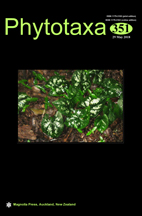Abstract
A multivariate analysis of the Pitcairnia palmeri group are presented. Principal Components and Cluster analyses were performed in order to have more accurate information to delimit the species. The analyses showed that the specimens referred to Pitcairnia palmeri var. longebracteata are clearly delimited, while those identified as P. palmeri var. palmeri, P. colimensis, and P. compostelae have a greater overlap of morphological characters, but remain as separate entities. A discriminant analysis showed that morphological characters used have significant multivariate differences between the taxa (P < 0.0005), and that the most important variables in the differentiation of these taxa are the percentage of floral bracts that exceeds the length of the sepals, the length of the floral bracts, and the length of the peduncle. We conclude that P. palmeri var. longebracteata is clearly a different species, not a variety, therefore is described and illustrated as P. robert-downsii, and that P. palmeri, P. compostelae and P. colimensis maintain their taxonomic status.

